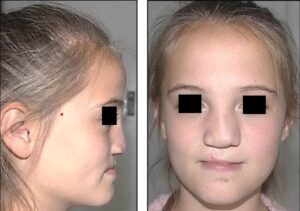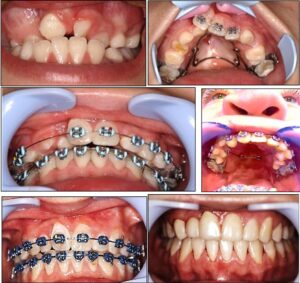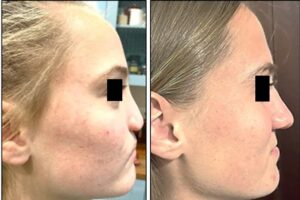Rolanda Prinsloo1*, Gieljam J Roode2, Kurt-W Bütow3
1Private Practice, Pretoria, South Africa
2Department of Anatomy, University of Pretoria, Pretoria, South Africa
3Private Practice, Life-Wilgers Hospital, Pretoria, South Africa
*Correspondence author: Rolanda Prinsloo, Private Practice, Waterglen, Pretoria, South Africa;
E-mail: [email protected]
Published Date: 18-09-2024
Copyright© 2024 by Prinsloo R, et al. All rights reserved. This is an open access article distributed under the terms of the Creative Commons Attribution License, which permits unrestricted use, distribution, and reproduction in any medium, provided the original author and source are credited.
Abstract
Nasomaxillo-acrodysostosis or Binder’s syndrome in a patient with a cleft lip and palate anomaly is infrequent. This case report underscores a unique surgical outcome achieved through an integrated orthopaeddontic and maxillofacial surgical approach within a multidisciplinary team. The treatment, initiated during a significant paediatric growth phase, was remarkably successful during the orthopaeddontic phase. The result obtained due to the successful early orthopaeddontic intervention significantly altered the initial plan for major midfacial orthognathic surgical reconstruction. As a result, the child born with this twin facial anomaly experiences a more typical development trajectory with fewer disruptions from extensive oro-facial reconstructions.
The case underscores the importance of early maxillary expansion across multiple dimensions during the critical paediatric growth period. This approach was pivotal in achieving a positive outcome, ultimately reducing the need for major invasive surgical procedures. The success of the treatment was also attributed to the dedicated collaboration among the healthcare professionals, the patient’s commitment and the family’s strong support.
Keywords: Cleft; Cleft Lip Palate; Nasomaxillo-Acrodysostosis; Binder Syndrome; Binderoid Appearance; Maxillonasal Dysplasia; Acrodysostosis; Orthopaeddontics; Surgery
Abbreviations
NMAD: Nasomaxillo-acrodysostosis; C: Cleft; L: Lip; A: Alveolus; P: Palate; hP: hard Palate; sP: soft Palate; u: unilateral
Introduction
The patient in this case was born with a rare combination of facial anomalies: a unilateral Cleft Lip-Alveolus-Hard-and-Soft-Palate (uCLAP) and a Nasomaxillo-Acrodysostosis (NMAD) [1,2]. The milder form of NMAD is known as Binder’s dysostosis or syndrome which contrasts with its more severe manifestation as an acrodysostosis [3,4]. Both NMAD and cleft lip, with or without additional oro-facial cleft involvement, present with similar midfacial hypoplasia. Diagnosing this combined oro-facial anomaly is challenging and often overlooked. In both anomalies, the maxilla is underdeveloped in the antero-posterior, superior-inferior and frequently transverse dimensions and is accompanied by some type of retro-nasal appearance. The diagnosis of NMAD in conjunction with an oro-facial cleft is rare and is highlighted in this case, with a particular focus on treatment interventions.
The treatment approach for this case, which involved a patient born with a rare combination of facial anomalies, differed somewhat from conventional orthopaeddontic application during the paediatric growth phase. The treatment plan initially anticipated major orthognathic midfacial reconstruction, including anterior positioning of the midface and Binderoid nasal skeleton reconstruction. However, the early paediatric orthodontic treatment, referred to as orthopaeddontic intervention, employed an arch-palatal activation-expansion appliance to correct both oro-facial and midfacial deformities [5]. This successful early orthopaeddontic intervention significantly impacted the treatment plan, ultimately allowing for a less invasive surgical route with exceptional results. The pre- and post- treatment orthopaeddontic and surgical outcomes are described and staged in this report.
Case Report
Nasomaxillo-acrodysostosis with Oro-Facial Cleft
Nasomaxillo-acrodysostosis (NMAD) presents across a broad spectrum, beginning with milder forms of maxillo-nasal dysplasia. Binder initially describes this as maxillo-nasal dysostosis although it has also been referred to as dysplasia anomaly, syndrome and Binderiod appearance [2,3,6,7]. This condition encompasses a broad spectrum of anomalies as far as those described in acrodysostosis [4]. Despite the range of manifestations, the main features always involve the nasal complex and the maxillary basal bone, but due to the possible wider diverges, always in conjunction with these particular facial features, it has been published as a nasomaxillo-acrodysostosis [1,2,8].
The patient in this report was diagnosed as an infant with a right-side unilateral CLAP and NMAD (Binderiod appearance) (Fig. 1). Additional features confirmed during orthopaeddontic treatment included relatively small frontal and maxillary sinuses, absence of a normal nasofrontal angle, hypoplastic nasal structure, absence of the anterior nasal spine, a small superior-inferior rounded nasal tip and mild hypertelorism [5,12]. This typical NMAD appearance, coupled with the cleft anomaly, is further characterised by an underdeveloped midface, a relatively protruding mandible with anterior mandibular vertical excess and a dental class-III-skeletal profile, consequently with a reverse overjet. Additionally, this paediatric female had a partially collapsed maxillary alveolar segment, a component of the cleft anomaly, with a prominent midline shift and typical rotated central incisors adjacent to the cleft alveolus.

Figure 1: a + b: Infant; c: Young child with CLAP + NMAD.
Orthopaeddontic Treatment of CLAP with NMAD
Early orthopaeddontic intervention was planned with future major surgical intervention [5]. This combined treatment plan aimed to establish an optimal facial balance in all three dimensions to secure a healthy harmony of the stomatognathic and mastication systems and strive for the one-third facial proportions in this patient born with both a cleft anomaly and NMAD (Fig 2). The pre-surgical orthopaeddontic treatment phase was implemented to prepare for secondary osteoplasty or osteofusion at the alveolar cleft [12,13]. It further involved maxillary expansion and mandibular stabilisation. After the eruption of permanent maxillary incisors, which appeared in a severe malposition due to the uCLAP, the alignment of maxillary teeth was completed before correcting the midline. Six months after the successful secondary osteofusion at the alveolar cleft, the maintenance phase was introduced [14]. The eruption of the permanent maxillary lateral incisor, adjacent to the alveolar cleft, occurred in a more palatial position but was successfully aligned into the arch due to the bone transplant, which provided sufficient support to advance the tooth into the arch. The integrity of the periodontal tissue was preserved and maintained.

Figure 2: a + b: Face – before commencing with orthopaeddontic treatment (CLAP + NMAD).
Rigorous orthopaeddontic treatment positively impacted facial aesthetics and improved the psychological difficulties associated with these two anomalies. The treatment normalised the relationship between the midface and dentoalveolar arch. The relationship between the maxillary and mandibular dentoalveolar arches improved so that the patient’s profile appeared nearly normal. The prosthodontic phase concluded the treatment. A centred midline, occlusal correction with balanced contact points, integrated working guides in the occlusion and cusp-to-fossa relationship was achieved (Fig. 3). This ensured appropriate dental and oral function, securing the control in a stabilised situation to reduce long-term relapse [14]. The combined treatment plan successfully avoided the need for extensive midfacial orthognathic surgery, typically applied in NMAD with the Binderoid appearance.

Figure 3: Intra-oral progression of the orthopaeddontic treatment for CLAP + NMAD with prosthodontic completion.
Surgical Treatment of CLAP and NMAD
The facial appearance associated with nasomaxillo-acrodysostosis or Binderoid appearances poses a significant challenge. Although the dento-alveolar arch of the maxilla is often well-developed, the basal or intermaxillary bone and the premaxillary arch with the anterior nasal floor are hypoplastic. This necessitates different surgical planning compared to cases with standard maxillary retrognathia or retrobrevignathia [15]. Treatment options for NMAD include: a) nasal and paranasal reconstruction with cartilage for the bridge, columella, canine fossa and sub-nasal augmentations around the hypoplastic anterior nasal spine; b) naso-orbito-maxillary osteotomy for the nasal complex with bone grafting; c) standard LeFort-I with additional nasal reconstruction; d) selective extraction of premolars in the maxillary arch to achieve a more retrognathic occlusal arch, coupled with midfacial deglove surgery involving a pyramidal LeFort-II osteotomy and nasal bridge and columella augmentation using thoracal cartilage [13,16-21].
The orthopaeddontic treatment successfully restored the relative facial proportions and jaw positioning (Fig. 4) [12]. The patient underwent secondary osteoplasty for alveolar cleft bone fusion, with additional paranasal bone augmentation at the canine fossa [13]. Following the post-orthopaeddontic treatment, nasal rib-cartilage augmentation was performed for the nasal bridge and the columella and a dimple effect was created at the lip philtrum edges in the prolabium [22]. A clinical decision was made not to perform midfacial orthognathic surgery for mild midfacial advancement to preserve velopharyngeal competency and the patient’s excellent speech production, given that this case involved a CLAP with a reconstructed cleft of the soft palate and an inherent shortage of soft tissue in the anterior-posterior dimension (Fig. 5) [9].

Figure 4: a: Pre-orthopaeddontic; b: Intermediate orthopaeddontic; c: Final orthopaeddontic and prosthodontic treatments for CLAP + NMAD.

Figure 5: a: Pre-surgical; b: Post-surgical facial reconstruction for CLAP + NMAD.
Discussion
This case presents a unique combination of facial anomalies, with NMAD being the primary feature, characterised by the hypoplastic part of the nasal complex and the maxillary basal bone. The involvement of these particular facial features, coupled with broader divergences found throughout the body, has led to the classification of the conditions as NMAD here observed in conjunction with a cleft anomaly (CLAP) [1,2]. Binder described several distinct facial features associated with this condition, including an arhinoid facial appearance with retro-nasal bone development, absent or severely atrophic anterior nasal spine and hypoplasia of the inter-maxillary or basal bone [3,7]. The hypoplastic maxilla often results in malocclusion, typically presenting as retrognathia, retrobrevignathia or micrognathia [15]. Consequently, this discrepancy manifests in the maxillary sagittal, superior-inferior and occasionally transverse facial development. With this prominent facial- skeletal deformity, additional non-obligatory anomalies are chronicled up to 13 features [1,4,8].
NMAD is further distinguished by the severity of the cartilaginous nasal septum hypoplasia, leading to a flat nasofrontal angle, a short columella with a rounded nasal nostril on the non-cleft side, a hypoplastic premaxilla and often retrograde cheekbones. The diagnostic features of NMAD, evident in this CLAP case, include the absence of the anterior nasal spine, the broad flat philtrum and a flat nasofrontal angle.
In this case, the patient presented with a right-sided unilateral cleft of the lip, alveolus, hard palate and soft palate (uCLAP) alongside NMAD. The primary reconstruction of the cleft anomaly was performed during infancy according to the standard CLAP protocol of the cleft unit without any complications [13].
Orthopaeddontic treatment principles were applied during the pre-surgical or pre-osteoplasty phase, followed by a post-op maintenance phase six months after osteoplasty. Following the eruption of all permanent teeth, final alignment was achieved. The results obtained during the pre-surgical orthopaeddontic phase were stable, such that even after secondary osteofusion and paranasal augmentation, the mild intermaxillary bone retrognathism did not warrant major orthognathic midfacial correction. The dentoalveolar arch form and the maxillary-mandibular relationship presented a stable and favourable outcome. The maxillary arch was sufficiently and successfully expanded during the pre-surgical orthopaeddontic phase, ensuring optimal interdental occlusion in the long term, leading to final prosthodontic stabilisation and safeguarding Wilson’s maxillary curve across the posterior occlusal plane [23].
The final dental aesthetics were achieved by placing crowns in the alveolar cleft region, allowing for the intimate maintenance of normal curves of Spee and Monson. Adequate lip support was also attained. The pre-orthopaeddontic retro-inclination of the permanent anterior maxillary and mandibular teeth was corrected to a normal inclination relative to the mandibular plane, resulting in a balanced occlusion expected to contribute to long-term occlusal stability [14].
The surgical reconstruction of the midface in NMAD hinges on the extent of this deformity, with various treatment options available [16-21]. The most involved orthodontic-surgical treatment type for severe NMAD includes midfacial deglove with a pyramidal LeFort-II osteotomy and nasal augmentation reconstruction [13]. However, due to the extensive interceptive orthopaeddontic treatment for the cleft anomaly, which corrected the arch position and occlusal interdigitation, the severity of the NMAD with its Binderiod facial appearances was minimised. Consequently, the surgical interventions required for this combined NMAD and cleft anomaly were less extensive, consisting mainly of standard secondary osteoplasty with bilateral paranasal bone transplantation and a nasal bridge-columella thoracal cartilage augmentation.
Conclusion
In this case, the long-term treatment from infancy to early adolescence demonstrated the successful outcomes achievable with thorough planning, the application of orthopaeddontic principles and minimal yet effective surgical intervention. This case of uCLAP with NMAD highlights the importance of timely and well-coordinated multi-disciplinary teamwork between an orthopaeddontist and a maxillofacial surgeon. The result was a well-balanced facial appearance with optimal functionality in occlusal interdigitation and speech production.
For this young patient, who is both a high-achieving sportswoman and an academically orientated scholar, the impact of avoiding additional major surgeries was profound. The minimised need for anaesthetic procedures and reduced hospital admissions significantly lessened the potential for psychological trauma, as well as the disruption of normal paediatric development.
This case underscores the importance of achieving normal facial growth and occlusal balance during the paediatric growth period. The early normalisation of the maxillary arch and dental treatment during the orthopaeddontic phase not only ensured a successful outcome for this patient but also provided valuable insights for managing similar cases in the future.
Conflict of Interests
The authors have no conflict of interest to declare.
Language Evaluation
AC Wolmarans.
Confirmation of Patient’s or Parent’s Permission
Patient/parent’s permission obtained.
References
- Bütow KW, Jacobsohn PV, De Witt TW. Nasomaxillo-acrodysostosis. S Afr Med J. 1989;75:5-11.
- Heńnekam CM, Krantz ID, Allanson JE. Binder anomaly (maxillonasal dysplasia). In: Gorlin’s syndromes of the Head and Neck. Oxford University Press. 2010;5:1124-6.
- Binder KH. Dysostosis maxillo-nasalis, ein arhinocephaler Missbildungskomplex. Dtsch Zahnärzl Z. 1962;17:438-44.
- Maroteaux P, Malamut G. L‘acrodysostosis. Presse Med. 1968;76:2189-92.
- Prinsloo R, Eroğlu Ç, Bütow KW. Cleft treatment: obturpaedics, orthopaeddontics, orthodontics – important concepts. J Dent Health Oral Res. 2024;5(1):1-5.
- Dyer FMV, Willmot DR. Maxillo-nasal dysplasia, Binder’s syndrome: review of literature and case report. J Orthod. 2002;29:15-21.
- Nedev P. The Binder syndrome: review of the literature and case report. Scripta Sci Med. 2008;40:153-6.
- Olow-Nordenam M, Radberg CT. Maxillonasal dysplasia (Binder Syndrome) and associated malformations of the cervical spine. Acta Radiol Diagn. 1984;25:353-60.
- Converse JM, McCarthy JG, Wood-Smith D, Coccaro PJ. Principles of craniofacial surgery. In: Reconstructive Plastic Surg. 2nd WB Sauders Co, Philadelphia. 1977:2463-5.
- Zeltser R, Bütow KW. Cleft lip and/or palate associated with naso-maxillo-acro-dysostosis. J Dent Res. 1992;71:1108.
- Bütow KW, Zwahlen RA. Paediatric facial cleft treatment – lessons learned. J Dent Health Oral Res. 2024;5(2):1-9.
- Prinsloo R, Bütow KW, du Plessis SM. Orthopaeddontics in cleft treatment. J Dent Health Oral Res. 2024;5(2):1-10.
- Bütow K, Zwahlen R. Cleft ultimate treatment. Reach Publishers’ Services, Wandsbeck, South Africa. 2016;2(40-42):252-3. https://issuu.com/iaoms/docs/layout/49
- Oltramari PPV, Conti ACD, Navarro RD, Almeida MR, Almeida-Pedrin RR. Importance of occlusion aspects in completion of orthodontic treatment. Braz Dent J. 2007;18(1):78-82.
- Bütow KW, Müller GW, De Mûelenaere JJGG. Profilocephalometric analysis: a combination of the cephalophotometric and the architectural structural craniofacial analyses. Int J Adult Orthod Orthogn Surg. 1989;4:87-104.
- Mehrotra R, Srivastava P, Katiyar A. Binder’s syndrome: a case report. Indian J Otolaryngol Head Neck Surg. 2019;71:S1757-61.
- Converse JM, Kawamoto HK, Wood-Smith D, Coccaro PJ, McCarthy JG. Deformities of jaws. Reconstructive Plast Surg. WB Sauders Co, Philadelphia. 1977;2:1456-7.
- Posnick JC. Binder syndrome: evaluation and treatment. In: Orthognathic Surgery: Principles and Practice. Elsevier Inc Publ. 2014:1159-81.
- Casson PR, Bonanno PC, Converse JM. The midface degloving procedure. Plastic and Reconstructive Surg. 1974;53(1):102-3.
- Price JC, Holliday MJ, Johns ME, Kennedy DW, Richtsmeier WJ. The versatile midface degloving approach. Laryngosc. 1988;98:291-5.
- Bütow KW, Jacobsohn PV, Duvenage JG, Nel F, Swart R, de Mûelenaere J. Treatment of the facial skeleton in naso-maxillo-acro-dysostosis. J Cranio-Max-Fac Surg. 1988;16:266-72.
- Naidoo S, Bütow KW. Philtrum reconstruction in unilateral primary cleft lip repair. Int J Oral Maxillofac Surg. 2019;48:716-9.
- Barrera JM, Llamas JM, Espinar E, Sáenz-Ramirez C, Paredes V, Pérez-Varela JC. Wilson maxillary curve analyzed by CBCT: a study on normocclusion and malocclusion individuals. Med Oral Patol Oral Cir Bucal. 2013;18(3):e547-52.
Article Type
Case Report
Publication History
Received Date: 26-08-2024
Accepted Date: 11-09-2024
Published Date: 18-09-2024
Copyright© 2024 by Prinsloo R, et al. All rights reserved. This is an open access article distributed under the terms of the Creative Commons Attribution License, which permits unrestricted use, distribution, and reproduction in any medium, provided the original author and source are credited.
Citation: Prinsloo R, et al. Oro-facial Cleft in Nasomaxillo-acrodysostosis (Binder): Orthopaeddontics and Surgery. J Dental Health Oral Res. 2024;5(3):1-7.

Figure 1: a + b: Infant; c: Young child with CLAP + NMAD.

Figure 2: a + b: Face – before commencing with orthopaeddontic treatment (CLAP + NMAD).

Figure 3: Intra-oral progression of the orthopaeddontic treatment for CLAP + NMAD with prosthodontic completion.

Figure 4: a: Pre-orthopaeddontic; b: Intermediate orthopaeddontic; c: Final orthopaeddontic and prosthodontic treatments for CLAP + NMAD.

Figure 5: a: Pre-surgical; b: Post-surgical facial reconstruction for CLAP + NMAD.


